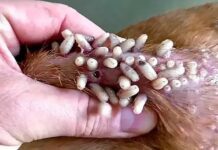One of the most sensitive places on your dog, and one of the most prone to getting dirty, are his ears, which is why you should pay special attention to them in order to prevent infections.
No doubt you have heard of several ways to clean a dog’s ears, but do you know what the correct way is? Or which way is completely not recommended? There is only one way to do it well without damaging your dog’s inner ear, so it’s really worth it to spend one minute reading this article.

When should I clean my dog’s ears?
Although ear hygiene isn’t generally given that much importance, it’s one of the most sensitive parts on your dog, and is also prone to getting infections.
You should check and clean your dog’s ears at least once a week. Depending on what your dog’s ears are like, their size, how dirty or dusty the places are where he goes for walks, plays, or lives, etc., it’s possible that some dogs will need their ears cleaned twice a week or more, while others might simply need a cleaning every ten to fifteen days.
Ears naturally produce wax, which is a way to protect the ear in all mammals, including humans. It’s completely normal that a dog would have dirty ears and need to be cleaned, since his body will always create more wax again.
Depending on the environment where your dog plays and lives, plus other external factors, this wax may trap more or less dust particles, keeping them from entering the ear. This is why there are times when the wax will be lighter or darker in color (except in the case of infection).
Generally speaking, a weekly cleaning is usually sufficient, keeping in mind that you need to dry the insides of his ears, just like if you were cleaning them, every time you bathe him. Dogs with cropped/mutilated ears (which is something you should never allow) tend to get dirtier more often.

How to clean your dog’s ears, step by step
The first thing you need to do is wash your hands and find a well-lit spot to visually check the inside of your dog’s ears. This initial check will tell you the amount of dirt you’re going to find, and in which parts of the ear you will find it.
It will also give you an idea of the size of the inside of your dog’s ears. This is very important, since you’re going to be manipulating it with your fingers and it’s a very sensitive area.
Once your visual inspection is finished, wrap some gauze around your finger and gently put it inside your dog’s inner ear. You should be very delicate, since any sharp movement could hurt him.
Logically, if your dog has small ears, you’ll use your pinky finger for this task, while if he has large ears (or is a large breed), you might want to use a different finger, but without forcing it.

Once you have gently introduced your finger wrapped in gauze inside his ear, make small, gentle circular movements, with the goal of catching as much wax in the gauze as possible.
Remove your finger with the gauze and examine it; if the gauze comes out dirty, with bits of wax or dirt, get a new piece of clean gauze and repeat the cleaning of that ear, as many times as necessary until the gauze comes out clean.
When you remove your finger with the gauze and it comes out clean, get a new piece of gauze (never use the same one) and do the same steps in the other ear. You should never use the same gauze for both ears, because if one ear is becoming infected, you’ll probably spread the infection to the other ear. You must always use a fresh piece of gauze for each ear.
Gauze is very affordable and you can buy it in different sized boxes at any drugstore. If you don’t have gauze, you can use clean toilet paper as long as it isn’t too rough.
Never, ever use cotton swabs (Q-tips) for a dog’s ears like we do in humans, because if the dog moves or if you miscalculate your movement with your hand, you can cause irreparable damage, including deafness. You shouldn’t ever use cotton balls or anything that will leave fibers behind, either.

How do I clean my dog’s ears and maintain his health?
If while cleaning your dog’s ears, you see excessive dirt or much more than he usually has, it’s possible that your dog has a fungal and/or bacterial infection.
Another symptom of an ear infection in dogs is an unpleasant (bad) odor inside his ears. If when you smell inside his ear, you notice a strong and/or unpleasant smell, he probably has an infection.
Excessive scratching by your dog or excessive shaking of his ears can also be signs of a possible infection.
If you see any of these symptoms, you should see your veterinarian so they can determine the type of infection and give you the proper treatment.

There are many different types of infections, so the medication won’t always be the same. On the other hand, there is no home remedy that will treat these types of infections – you must see your vet, no ifs ands or buts.
Always clean your dog’s ears with dry gauze; you should only use ear cleaning solutions for dogs if your veterinarian tells you to.
Obviously, if you find any ticks or fleas on your dog, you should take action to get rid of them.

Useful tips for cleaning your dog’s ears
- Don’t use products or home remedies, just dry gauze
- Don’t force it, do it gently and delicately
- Never use cotton swabs (Q-tips) or products that leave behind fibers
- Check and clean his ears at least once a week





